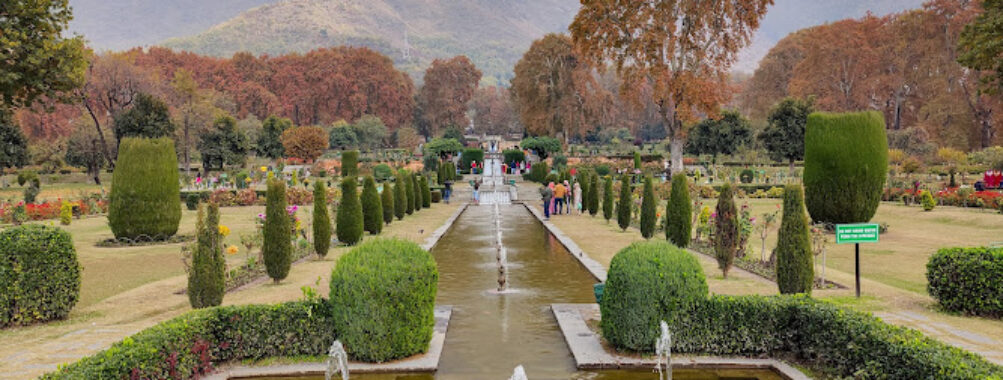
Nishat Garden
Table of Contents
Description
There’s something quietly magical about the Nishat Garden in Srinagar. It’s one of those places that doesn’t rush to impress you—it just sits there, gently unfolding its charm the longer you stay. Built way back in 1633 by Asif Khan, the brother of Nur Jahan, this Mughal masterpiece still carries the same sense of grandeur and calm that must’ve drawn emperors and poets centuries ago. The garden stretches across twelve terraced levels, each one a little higher, a little more breathtaking than the last. And if you stand on the upper terrace, with Dal Lake shimmering below and the Zabarwan Range standing tall behind, you’ll understand why they called it the “Garden of Delight.”
Unlike some other Mughal gardens that feel too manicured, Nishat has this lived-in beauty. You’ll see families picnicking under the chinar trees, kids chasing each other around the fountains, and couples quietly sitting by the pools, lost in conversation. It’s not just a monument—it’s a living, breathing part of Srinagar’s rhythm. The sound of cascading water fills the air, mixing with laughter, distant calls of shikara boatmen, and the occasional rustle of leaves. Honestly, it’s hard not to feel a little poetic here.
Of course, not everything is perfect. Sometimes the crowds can be a bit much, especially on weekends. And yes, a few areas could use better maintenance. But even with its flaws, Nishat Garden has this undeniable pull—like a well-loved book with worn-out pages that you keep returning to. It’s serene, historic, and somehow deeply personal. You don’t just visit it; you experience it.
Key Features
- Twelve Terraces: Each terrace represents a different level of beauty and design, with flowing water channels connecting them all.
- Central Water Canal: A symmetrical stream runs through the center, fed by natural springs from the nearby mountains.
- Fountains and Pools: The rhythmic splash of fountains adds a soothing soundtrack to your stroll.
- Chinar and Cypress Trees: These towering trees, some centuries old, offer shade and a sense of timelessness.
- Floral Beds: Depending on the season, you’ll find marigolds, tulips, and roses painting the garden in soft colors.
- Panoramic Views: The view of Dal Lake from the upper terraces is simply unforgettable—especially at sunset.
- Mughal Architecture: The garden’s layout follows the traditional Persian “Charbagh” concept, symbolizing paradise on earth.
- Family-Friendly Atmosphere: It’s a great spot for picnics, casual strolls, and even children’s birthday outings.
Best Time to Visit
If you ask locals, they’ll tell you there’s no bad time to visit Nishat Garden—but some seasons do have their own charm. Spring (March to May) is perhaps the most enchanting. The flowers burst into bloom, the air smells fresh, and the snow still glistens on the mountains. Summer is lively, though a bit crowded, with tourists from all over coming to escape the heat of the plains. Autumn, though—now that’s something else. The chinar trees turn fiery red and gold, and the whole garden feels like it’s been dipped in warm honey. Winter has a quiet beauty too, when mist hangs low and the fountains freeze in delicate patterns. I once visited in December, and though it was cold enough to make my fingers ache, the stillness was almost meditative.
How to Get There
Getting to Nishat Garden is quite straightforward. It’s located along the scenic Boulevard Road, which hugs the eastern edge of Dal Lake. If you’re staying in Srinagar, you can easily reach it by taxi, auto-rickshaw, or even a rented bike if you’re feeling adventurous. Many visitors prefer taking a shikara ride across the lake—it’s slower, sure, but the view is worth every minute. You’ll glide past floating gardens, lotus patches, and houseboats before arriving right at the garden’s edge. Public buses also run along the main road, though they can be a bit unpredictable with timing.
For those coming from the airport, it’s about a 40-minute drive, depending on traffic. Early mornings are the best time to head out—the roads are quieter, the air crisp, and you’ll catch the first rays of sunlight hitting the water. It’s one of those moments that stays with you long after the trip ends.
Tips for Visiting
Here’s the thing about Nishat Garden—it rewards those who slow down. So don’t rush through it like just another stop on your itinerary. Take your time. Sit by the fountains, watch the reflections dance, and let the place sink in. That said, a few practical tips can make your visit smoother:
- Go early or late: Mornings and late afternoons are less crowded and the light is perfect for photos.
- Carry cash: Entry tickets are inexpensive, but card payments aren’t always accepted.
- Wear comfortable shoes: The terraces involve a fair bit of walking and climbing.
- Pack a small picnic: There’s something special about eating under those ancient chinar trees.
- Respect the space: It’s not just a tourist spot—it’s part of local heritage. Avoid littering or stepping into flowerbeds.
- Visit nearby attractions: Combine your trip with stops at Shalimar Bagh or the Dal Lake shikara ride for a full day of exploration.
- Photography tip: The best shots are from the upper terraces looking down over the lake, especially around golden hour.
And one more thing—don’t forget to simply breathe it all in. The scent of the soil after a light rain, the way the sunlight filters through the chinar leaves, the laughter of families echoing across the terraces—it’s all part of the experience. Nishat Garden isn’t just about history or design; it’s about feeling connected to something timeless. When you leave, you’ll probably find yourself already planning to come back. I know I did.
Location
Places to Stay Near Nishat Garden
Find and Book a Tour
Explore More Travel Guides
No reviews found! Be the first to review!